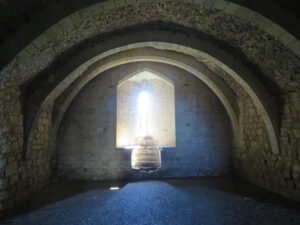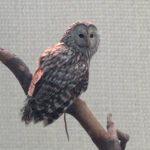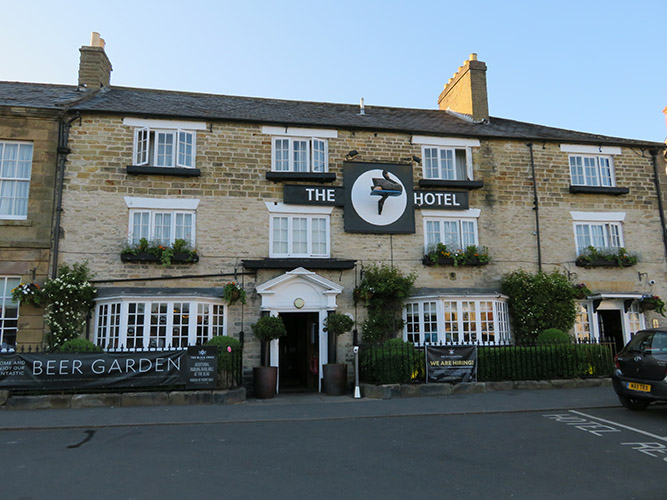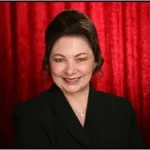The next day was Saturday, so after breakfast we made our way to Helmsley for the book signing. I met Mandy, the owner, and she showed me the store and where I would be sitting. On a raised level of the store, in the fiction section, she had set up a round table with a pile of my books and she put a basket of sweets next to them. I put out a description of what The Blythewood Curse was about, a table tent showing the covers of all my other books, and then proceeded to sign all the books she had ordered. Mandy worked the front register, which had a table nearby with author signed books.
We also meant Deborah, who works in the store. While she shelved books, she stopped and chatted with us about the book, which she had read and really enjoyed. It’s always nice to have someone local who can speak from actually having read the book. She said that as far as she knew, no one had ever written a book that takes place in Helmsley, which should make it a standout item for the store. Vere also did a bit of sales work sitting next to me. With busloads of people getting off at the large parking lot right next to the bookshop and people walking in constantly, I sold many books just sitting there, and I think the book will do well all through the summer. After the signing was over, we said our thanks and Vere took a picture of Mandy and me in front of the store.
We went to lunch at a nearby café. It had turned into a pleasant day of 70º F. for us, but for Brits that’s hot. Vere looked around in the shops for a tee-shirt to change into instead of his long-sleeved dress shirt and jacket that he had worn for the signing, but the shop there only had ones for £40! Instead, he rolled up the sleeves and put his dress jacket in the car. Since the timing for parking was limited, we drove to another nearby parking lot where we could visit the medieval ruins of Helmsley Castle, just a couple blocks away.
In 1066, Count Robert of Mortain, the half-brother of King William the Conqueror, was granted the land and area around Helmsley after fighting at the Battle of Hastings. His likeness appears embroidered on the famous Bayeux Tapestry, seated with his brothers. But there is no evidence that he built anything in Helmsley. There is evidence that in 1120 a Walter l’Espec built a wooden castle on a rocky outcrop overlooking the River Rye, which had double ditches surrounding a rectangular inner bailey. Helmsley Castle was often used as a place of safety during tumultuous times.
When Robert died, the castle passed on to his sister, who married a man named Peter de Roos, and it was he who converted the wooden castle into stone, adding a main gateway on the south side and two towers. When he passed on, the castle went to his oldest son, William, who added a chapel. William’s son, Robert, inherited the castle and was Lord of Helmsley from 1258 to 1285. He added a new hall and kitchen and an impressive barbican and strengthened all aspects of the castle. King Edward III once stayed at the castle in 1334. Helmsley Castle remained in the possession of the de Roos family until 1478 when Edmund de Roos sold it to the Duke of Gloucester, who later became Richard III. Upon his death, the castle reverted to the de Roos.
The castle again passed hands through several families and eventually was converted into a Tudor mansion in the 1500s. During the English Civil War, the castle was besieged by Sir Thomas Fairfax in 1644. Parliament ordered the castle to be destroyed, and much of the walls, gates, and part of the east tower were demolished, though the mansion was spared.
In 1695, the castle was sold to Charles Duncombe, a banker and politician, who became the Lord Mayor of London in 1708. His sister inherited the castle, and her husband, Thomas Brown, had a country house built at Duncombe Park to overlook the decaying castle. Eventually the town used the grounds for fairs and shows. In 1923, the Office of Works cleared the debris and eventually the castle grounds came under the care of English Heritage.
The walkway to enter the castle grounds circled to the left around the base of the hill on which it stood, although little could be seen of the castle as the path was so low. As we rounded the far left side we approached the lower gate house, which we passed through, and could at last view the castle tower. Then we could see how deep the moat had been, as a long bridge reached across it to the other side where the ruins stood. At the top of the hill we could see the remains of the manor that had once been the castle and the broken low walls of stone scattered across a wide grassy area.
First, we climbed the entrance stairs to the museum on the second floor. Part of the ancient ceiling remained, along with the walls and the fireplace. Then we went downstairs to a side tower, to explore the ground floor, or rather what was left of it. We could see all the different floors as there were remnants of a fireplace on each level. Then we went down into the undercroft.
We walked all around the broken stone walls and around the remains, one of which was a fine tower, though only the front and a side were standing and the other sides had fallen in. The sky was absolutely clear and blue, the grass was bright green, and the stone walls were mottled gray. Gravel pathways around stubble walls covered in lichen and small purple flowers made the entire site quite attractive. We rather enjoyed Helmley Castle. Even though not a lot of it had remained, we could see how it had at one time been a handsome place to be.
From there, we only had to go a mile or so to the bird aviary at the National Center for Birds of Prey on the edge of Duncombe Park. We arrived about forty minutes before the bird show, so we walked around the bird cages to enjoy seeing all the different owls, hawks, falcons, eagles, buzzards, kites, and vultures within their forty aviaries. It was explained that the aviary enclosures with three solid walls gave the birds a sense of security and made it better for them to feel free to breed. Some birds were actually outside of their aviaries, tethered to posts in the shade next to large water bowls, enabling the visitor to see them without looking through a metal screen.
We stayed for the 4:15 bird flight show. Handlers came out four times with different birds and talked about each one, while they walked back and forth between posts where the birds could fly around and then land and receive treats. One long-eared owl landed at our table twice, its brown eyes blinking at us with amusement. It was all over too soon, but we enjoyed it.
Then back to downtown Helmsley where we parked to have dinner at the Black Swan.
We ordered drinks and toasted to a successful book signing. I had a great-tasting cocktail that was made with rhubarb gin, amaretto, orange and lime juice, and grenadine syrup. While waiting for our dinner I went to speak with the manager of the hotel/restaurant. I told her about my book, that I had just finished a book signing, and that the Black Swan is mentioned seven times in the book. I left her my name and the name of the book; she thanked me for mentioning them and said she was going to get a copy of the book.
For dinner, Vere and I shared a starter of cheese and spinach soufflé. Then Vere had the pie of the day, which was steak and ale with mashed potatoes and chard. I had the pan-roasted chicken breast with pearl onions, mushrooms, and creamy mead sauce with mash and Chinese peas. Then we both splurged and had dessert. He had the lemon and orange cake and chocolate ice cream with orange sauce, and I had the rhubarb crisp with custard sauce.
On the way back to our B&B, I realized I still had one extra signed copy of my book. I had originally thought to leave a copy at the town library, but it had closed early. So I decided to give it to Ryan and Andy at the B&B. With as many guests as they have coming all summer long, it will get much more exposure in their B&B than at the library, hidden among others on a shelf. I gave them the book, and they were very thankful.

























 The official website of Lita-Luise Chappell, writer on sex, magic, food, distant lands, and everyday life with articles, poetry, novels, travelogues, rituals, cookbooks, and short-stories.
The official website of Lita-Luise Chappell, writer on sex, magic, food, distant lands, and everyday life with articles, poetry, novels, travelogues, rituals, cookbooks, and short-stories.
